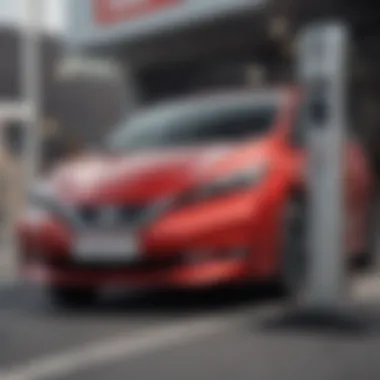Charging Your Nissan Leaf: Essential Tips and Insights


Intro
In today's rapidly changing automotive landscape, electric vehicles (EVs) have carved out a significant niche, and the Nissan Leaf stands as a pivotal player in this realm. As electric cars become more prevalent, understanding how to charge them effectively is not just a bonus—it's essential. This guide will navigate the ins and outs of charging a Nissan Leaf, equipping both current owners and potential buyers with the know-how to maximize their driving experience.
Nissan Leaf owners often face dilemmas revolving around charging options, battery health, and proper maintenance routines. Charging an electric car isn't like filling up at the gas station. It's a whole different ballgame that requires a bit of learning and planning. The following sections will delve into charging methods, the nature of EV batteries, and maintenance tips that can help enhance the longevity of your vehicle’s battery. Understanding the charging infrastructure will also be essential, especially in a world where public charging stations are becoming more common.
With the Leaf being one of the top-selling electric vehicles, its appeal lies in its practicality and balance of affordability and efficiency. Let’s take a closer look at how to make the most out of your Nissan Leaf, starting with automotive features and innovations that contribute to its charging capabilities.
Understanding Electric Vehicle Charging
Charging an electric vehicle, especially a Nissan Leaf, holds immense significance in today's world. It is more than just about filling a tank; it’s about understanding a system that’s transforming how we perceive transportation. As electric vehicles (EVs) gain traction, grasping the mechanics of charging becomes fundamental not only for current owners but for prospective buyers as well.
The main benefit of understanding EV charging is the empowerment it gives you as a user. From being aware of the various charging options to recognizing optimal practices that prolong battery life, knowledge in this area can boost your experience and enhance the longevity of your vehicle. Moreover, as innovations surface, having a keen understanding of these technologies can keep you ahead of the curve.
The Evolution of EV Charging Technology
Over the years, EV charging technology has advanced significantly. In the early days, charging infrastructure was almost non-existent. Users were left to plug into regular outlets, a far cry from the sophisticated systems we have today. With the dawn of technologies such as Level 2 and fast charging, EV owners can now recharge their vehicles in a fraction of the time that was once required.
Moreover, the introduction of smart charging stations adds another layer of convenience. Many of these units can communicate with an EV to optimize safety and charging speed, improving the overall efficiency of the process. Thus, these developments reflect not only technological progress but also our growing commitment to sustainable transportation.
Basic Components of EV Charging Systems
Charging Stations
When you think of charging your Nissan Leaf, charging stations play a pivotal role. These are the physical spots where the actual charging takes place. What makes them invaluable is their accessibility; they are increasingly found in parking lots, shopping centers, and other public locales.
A key characteristic of these stations is their various charging speeds. You'll find slow chargers that can take hours and fast chargers that can replenish a substantial portion of your battery in under an hour. This diversity caters to different user needs—whether you're at home or on the go, there's always a suitable solution.
An interesting feature of contemporary charging stations is their integration with mobile apps, allowing users to monitor charging progress or find nearby stations with ease. However, one downside to this is that not all stations are created equal. Variability in charging speed and compatibility can sometimes lead to frustration.
Electric Vehicle Supply Equipment
Electric Vehicle Supply Equipment (EVSE) serves as the backbone of any effective charging strategy. This equipment encompasses everything from cables and connectors to charging units, playing a vital role in ensuring that electricity flows safely and efficiently to your Nissan Leaf.
One of the standout characteristics of EVSE is its ability to detect and communicate with the car to ascertain the optimal way to deliver power. This user-friendly feature prevents overloading and potential hazards, making it a reliable option for EV owners.
However, the challenge lies in the variety of EVSE available in the market. Choosing the right equipment according to your specific needs can be a bit of a puzzle, particularly for newcomers. It's crucial to pick equipment that aligns with your charging habits, whether at home, workplace, or public locations.
Understanding both charging stations and electric vehicle supply equipment leads to a more efficient and stress-free experience. Choosing the right setup directly affects battery performance and longevity.
Nissan Leaf Charging Options
Nissan Leaf owners are often on the lookout for the most effective charging methods available to them. Understanding the various charging options not only equips you with the knowledge you need to maximize your vehicle's efficiency but also helps you make informed decisions about your energy consumption. The right setup goes a long way in ensuring that your driving experience is smart and eco-friendly.
Home Charging Setup
The convenience of charging at home is unarguable. It eliminates the uncertainty that comes with searching for public charging stations when your battery runs low. Moreover, charging your Nissan Leaf at home typically means you can benefit from lower electricity rates, especially if you're able to charge during off-peak hours.
Level One Charging
Level One charging is the most straightforward method for charging your Nissan Leaf. It uses a standard household outlet, which most people have available in their homes. This type of charging is often viewed as a basic necessity, so why is it still relevant?
One important characteristic of Level One charging is its universal accessibility; there's no need for specialized equipment or installation. You simply plug in your car and let it charge. However, this convenience comes at a price. The charging rate is quite slow, typically adding only about 4 to 5 miles of range per hour.
Advantages of Level One Charging:


- Ease of Use: Just plug the car into the outlet.
- No Installation Costs: Often no additional equipment investment required.
Disadvantages of Level One Charging:
- Slow Charging Time: Not ideal for those needing a quick recharge.
- Limited Usability: Better for overnight charging than quick top-ups during the day.
Level Two Charging
Level Two charging ups the ante in terms of functionality. Typically found in homes with dedicated EV chargers, this method allows for much quicker charging times. With a Level Two charger, you can gain about 10 to 20 miles of range for every hour of charging.
The standout feature of this type of charger is the increased voltage it uses, which significantly reduces the amount of time your Nissan Leaf has to stay plugged in. For many users, this means less time waiting and more time driving.
Advantages of Level Two Charging:
- Fast Charging: An ideal choice for busy individuals needing quick top-ups.
- Improved Range Accessibility: Great for longer trips or irregular charging habits.
Disadvantages of Level Two Charging:
- Installation Costs: Requires an upfront investment and potentially some work on your electrical setup.
- Limited Availability: Not every home may have the infrastructure for a Level Two charger.
Public Charging Infrastructure
While home charging is convenient, it's essential to know about public charging points, especially during longer journeys. Utilizing public infrastructure for charging can be a lifesaver when you're on the go.
Fast Charging Stations
Fast charging stations are a beacon for electric vehicle owners who require a fast recharge. These stations can provide a substantial charge in a fraction of the time it would take at home. Depending on the specific station, a Nissan Leaf can achieve an 80% charge in about 30 minutes.
The unique feature of fast charging stations lies in their high charging capacity, using DC fast charging technology. While they are not meant for daily use, they offer a critical solution for long trips or urgent situations.
Advantages of Fast Charging Stations:
- Rapid Recharge: Perfect for those needing to quickly top off their battery before continuing on.
- Extended Travel Range: Enables longer trips without excessive planning.
Disadvantages of Fast Charging Stations:
- Cost Variability: Charges may vary by location, and some stations can be pricey.
- Limited Locations: Not all areas are equipped with fast charging stations, necessitating planning ahead.
ChargePoint Networks
ChargePoint Networks are known for their extensive coverage and user-friendly interface. Being one of the larger charging networks in the country, ChargePoint provides easy access to various charging stations. You'll find both Level Two and fast chargers available, enhancing convenience.
What makes ChargePoint a favorable choice is the mobile app that allows users to locate available chargers, monitor their charging status, and receive notifications when charging is complete. This level of interactivity makes it simpler to plan your charging strategies effectively.
Advantages of ChargePoint Networks:
- Widespread Coverage: Users are more likely to find a station when they need it.
- User Convenience: Real-time information saves time and enhances your experience.
Disadvantages of ChargePoint Networks:
- Membership Fees: Some services might involve subscription fees.
- Chargers Availability: Popular stations might be busy, leading to wait times.
Workplace Charging Solutions
The prospect of charging at work can provide Nissan Leaf owners with an added layer of convenience. Companies are increasingly taking notice of EV charging solutions, offering workplaces that support EV owners with charging options. These solutions can make a world of difference, especially for those who commute daily.
How to Charge Your Nissan Leaf


Understanding how to charge your Nissan Leaf is at the heart of effective electric vehicle ownership. Charging isn’t just about plugging in; it involves choosing the right method and strategy to optimize performance and maintain battery health. Each charging process carries its nuances, and being aware of these can vastly influence your driving experience. For those new to the realm of electric vehicles, this section will serve as a guide through every facet of charging your Leaf, from practical connection methods to understanding various charging modes, ensuring you’re well-equipped to power your journey.
Step-by-Step Charging Process
Connecting to the Charger
The first step in the charging process is undeniably connecting to the charger. This act might seem trivial, but it sets the stage for the entire charging experience. The Leaf has a unique feature, which is its multiple charging ports, catering to different charging methods. When you connect your vehicle, you must identify whether you are using a Level One or Level Two charger. Level One chargers utilize a standard wall outlet, while Level Two chargers offer faster charging via dedicated stations.
This easy access makes it a popular choice for many Nissan Leaf owners; it allows for flexibility in daily charging routines. One advantageous characteristic of connecting to Level Two is that it can significantly cut down your wait time. However, it does require appropriate installation and setup, which might be a downside for some users, particularly if dealing with older homes lacking the necessary amperage.
Monitoring the Charging Status
Once the Leaf is connected, paying attention to the monitoring of the charging status becomes crucial. Most models come equipped with a clear dashboard interface that displays current charging levels and time estimates. This feature allows users, especially those on tight schedules, to keep track of how quickly they are powering up their vehicle.
The ability to check the charging status remotely, whether through a smartphone app or directly on the car's display, is another innovative characteristic that adds convenience. Yet, it’s essential to note that reliance on this monitoring doesn’t mean one should ignore the battery's health. While convenient, consistently overcharging can lead to potential battery degradation down the line.
Selecting the Right Charging Mode
Normal Charge vs. Eco Mode
When charging your Nissan Leaf, there's an important decision to make regarding Normal Charge vs. Eco Mode. Normal Charge typically fills the battery quicker, using the maximum power available. However, Eco Mode is designed to extend battery life by using a less aggressive charging strategy. This is a key consideration for those who put a premium on sustaining battery health over speed.
Eco Mode not only contributes to lower energy consumption but also often delivers better overall efficiency for everyday users. While Normal Charge may feel faster, Eco Mode plays a significant role in ensuring that the battery remains in optimal condition for a much longer period, benefit that shouldn't be overlooked.
Schedule Charging Times
Another aspect to consider is Schedule Charging Times. Many charging stations and home systems allow you to set specific times for charging. Scheduling can take advantage of off-peak electricity rates, significantly reducing costs. For example, charging overnight can prove to be savings in your pocket while ensuring that your vehicle is ready every morning.
This feature not only helps in reducing expenses but also allows you to mitigate any stress related to finding charging opportunities during the day. One downside might be the need to be a bit savvy with your local utility rates. Overall, scheduling your charging can provide a win-win scenario, marrying your economic needs with the functionality of your Nissan Leaf.
Factors Influencing Charging Times
Charging times for a Nissan Leaf can vary quite a bit, and understanding these factors is key for efficient EV ownership. Knowing what impacts charging can help you plan your trips better and avoid any surprises. Here, we'll dive into the nitty-gritty of what really dictates how long it takes to juice up your Leaf.
Battery Capacity and State of Charge
Battery capacity is one of the primary players in the charging game. It defines how much energy your Nissan Leaf can store and directly affects how long it takes to charge. If you're starting out with a nearly empty battery—think a state of charge (SoC) hovering around 10%—it makes sense that the charging time will be longer than if you're topping off from 70%.
This is primarily because of how lithium-ion batteries behave. They're like sponges that can soak up a lot of water quickly when they're thirsty, but that rate slows down as they reach their full capacity.
- Short Charge Times: If your battery is low, you may notice that the first part of the charge takes less time compared to when the battery is 80% full or more. It can get tricky.
- Monitoring SoC: A quick peek at your vehicle's dashboard interface will give you a clear picture of your battery's current state. Eager to charge? Keep an eye on the SoC to gauge your charging progress.
Power Supply and Circuit Ratings
The second big component influencing charging times is really the power supply and the circuit you're connected to. Different charging stations offer various power levels, which means that not all chargers are created equal.
- Level One Charging: This typically provides around 120 volts, about the same as a standard household outlet. If you're using this method, your Leaf might take a long time to juicie up fully.
- Level Two Charging: When you step up to a 240-volt setup, you're looking at a much faster charging time. For instance, with a Level Two charger, you could go from empty to full in about 4 to 8 hours, depending on battery size.
- DC Fast Charging: This is the king of speed. If you can find a DC fast charging station, your Leaf could gain about 80% charge in as little as 30 minutes. However, such chargers are not available everywhere.
Moreover, the actual amperage and wattage of the circuit will also play a part. If you're plugged into a lower-rated circuit, it’s just a slow ride to a full charge.
"Knowing your power supply can save a world of hassle when it comes to charging your Nissan Leaf."
It's clear that both battery capacity and power supply ratings significantly determine charging durations. By aligning your charging strategy with these factors, you can optimize your Leaf's recharging protocols. Proper planning ensures that you spend less time tethered to a charging station and more time on the road enjoying your electric vehicle.
Maintaining Battery Health


Maintaining the health of your Nissan Leaf's battery is crucial for ensuring the longevity and efficiency of your electric vehicle. A healthy battery not only extends the overall life of the vehicle but also enhances its performance and range. Regular maintenance and awareness of charging practices can prevent premature battery degradation, which can be a costly and inconvenient problem for owners.
Most importantly, understanding the best practices and potential issues related to battery health can transform your driving experience altogether.
Best Practices for Charging
Optimal Charge Levels
Keeping your battery within optimal charge levels is key for its health. Charging your Leaf between 20% and 80% is often recommended. This range helps avoid the strain placed on the battery that can occur when running it near full capacity or allowing it to discharge too low. Many drivers find this advice practical since keeping the battery within a moderate range can prolong its overall lifespan.
The unique feature of this method is how it balances convenience and care; you don't always need a full charge for daily drives.
Advantages
- Extended Battery Life: Consistent charging within this range significantly slows down the degradation process.
- Efficient Use of Energy: A mid-range battery charge translates into more consistent energy availability and less frequent charging sessions.
Disadvantages - Range Anxiety: Some drivers might feel uneasy knowing their battery isn’t topped off; however, a little planning can alleviate this concern.
Minimizing Extreme Temperatures
Keeping the battery within a moderate temperature range is extremely important for its health. Exposure to high heat or cold can compromise battery performance and longevity. Parking in shaded areas or using a garage can be effective solutions to this problem.
The benefit of this practice is that it aids in maintaining the effectiveness of your battery's charge cycle. Heat can accelerate chemical reactions within the battery, leading to quicker degradation, while cold temperatures can reduce efficiency during charging.
Advantages
- Prevents Damage: Protecting your battery from extreme temperatures can significantly reduce the chance of physical or chemical damage.
- Improved Performance: A battery that operates within ideal temperature conditions is more reliable, maintaining performance and efficiency.
Disadvantages - Limited Charging Locations: If you primarily charge in extreme conditions, you may have to work harder to find optimal spaces, presenting a logistical challenge.
Troubleshooting Common Issues
Charger Not Working
If your charger isn’t working, it can be frustrating, especially when you’re in need of a quick charge. This issue may arise from various factors, such as a faulty outlet, damaged charger, or setup configurations.
Understanding this issue helps in identifying it quickly and reaches a resolution expeditiously. Many Nissan Leaf drivers have experienced this problem but once figured out, can choose to either replace the faulty unit or call an electrician to check the home connection.
Advantages
- Simplified Solutions: Identifying the issue early on can save you from unnecessary expenses.
- Knowledge Boost: You gain better awareness of your charging systems and infrastructure.
Disadvantages - Downtime: If the charger is out of commission, you risk not being able to charge during critical times.
Battery Overheating
Battery overheating can happen for a number of reasons including rapid charging or exposure to excessive heat. If you notice your Nissan Leaf’s battery temperature rising above normal levels, that’s a red flag. Understanding the signs of overheating and taking preventive action is essential. Some owners choose to limit fast charging to reduce this risk.
Highlighting this aspect ensures that drivers remain vigilant about the signs of battery stress. A worrisome overheating battery can lead to decreased performance or worse, a safety hazard.
Advantages
- Safety First: Being aware lets you act before it becomes a dangerous situation.
- Performance Maintenance: Preventing overheating helps in preserving battery efficiency in the long run.
Disadvantages - Potential Last-Minute Repairs: If the situation goes unnoticed, repairs or replacements could be needed, adding to costs and downtime.
Keeping your battery in good shape is worth it; after all, a little attention today could mean a smoother ride tomorrow!
Future Trends in EV Charging
The landscape of electric vehicle (EV) charging is shifting beneath our feet, much like the wheels of a Nissan Leaf on a winding road. Understanding these trends isn’t just a matter of keeping up; it’s about anticipating how we’ll be powering our vehicles in the not-so-distant future. Integrating new technologies and navigating regulatory changes mean that both current and prospective Leaf owners need to stay informed. From innovations in charging technology to shifts in government policies, these trends are paving the way for a more accessible and efficient charging experience, ultimately benefiting drivers and the environment alike.
Emerging Technologies
Wireless Charging
Imagine a world where you simply park your Nissan Leaf over a designated surface and walk away, no fuss with cables or plugs. That’s the future wireless charging holds. This technology eliminates the need for physical connectors, making the charging process seamless and user-friendly. The key characteristic of wireless charging is its capacitive or inductive nature, which transfers energy through an air gap.
Such a feature could significantly reduce wear and tear on both the charging equipment and your vehicle. While it sounds like an ideal solution, there are still some challenges. The efficiency can drop compared to traditional charging, and the infrastructure isn't widely available yet. But as development continues, the advantages may outweigh the downsides.
Ultra-Fast Charging Solutions
Ultra-fast charging is redefining the time it takes to recharge an EV, allowing drivers to get back on the road in what feels like a blink. This technology utilizes high-power charging stations capable of providing substantial energy in mere minutes, instead of hours. The standout aspect of ultra-fast charging lies in its astounding capability to deliver charges of over 350 kW.
For the Nissan Leaf owners, this can result in significantly reduced waiting times during long trips. However, this advanced tech isn’t without its caveats. Increased charging speeds can potentially cause more heat in the battery, raising concerns about longevity and battery health. Nonetheless, as EV adoption rises, this trend appears promising, especially for drivers on the go.
Government Regulations and Incentives
Incentives for Home Charging Installations
To encourage the adoption of electric vehicles, governments are introducing incentives that make setting up home charging installations more affordable. These incentives often take the form of tax credits, rebates, or grants aimed to lower the initial costs of purchasing and installing a home charging unit. The benefit of this approach is multiple. Not only do these incentives ease financial burdens on Nissan Leaf owners, but they also foster a stronger EV ecosystem by encouraging residential charging solutions.
That said, homeowners should be cautious and ensure they understand the specific requirements to qualify for these incentives, as guidelines can vary widely.
Future Urban Planning Considerations
Urban planning is adapting to the increasing number of electric vehicles on the roads. Cities are in the process of incorporating EV charging stations into new developments and public spaces. This foresight is not just beneficial; it’s essential for accommodating a future where electric vehicles dominate the market.
A key feature of this trend is the integration of solar-powered charging stations, which could drastically reduce reliance on grid power. While this is a forward-thinking solution, it does take time and substantial investment before it becomes the norm in every city. As urban areas evolve, the resulting infrastructures should ideally provide convenient access to charging stations, making electric vehicle ownership more appealing and practical.







